Feny? D. (Ed.) Computational Biology
Подождите немного. Документ загружается.

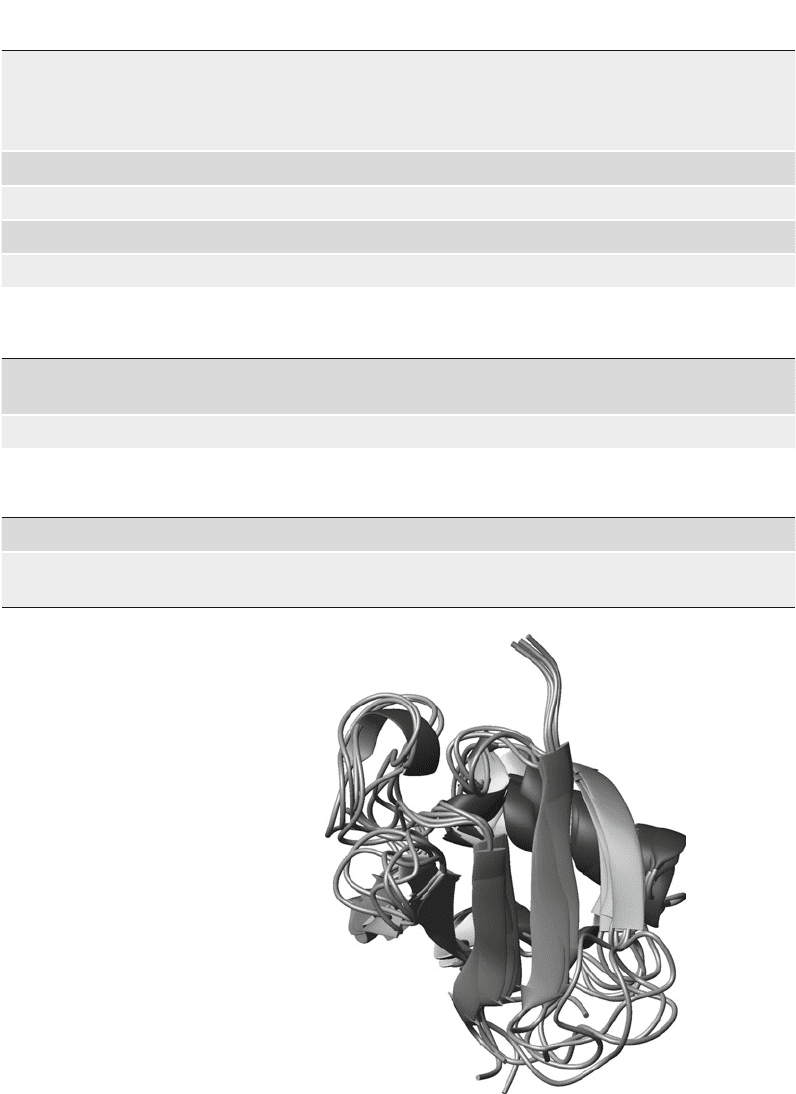
110 Gronwald and Kalbitzer
Table 1
(continued)
Parameter Value Description
Assign all peaks No Switches additional assignment of signals on
where “mutual information probability
limit” and “lower probability limit” values
are below thresholds
Assignments to master list Yes Transfers assignments to spectrum
Specify error bounds Yes Manual definition of error bounds
Upper bound (see Note 25) dist
2
/8 Calculation of upper bounds in CNS restraint file
Lower bound (see Note 25) dist-0.165 nm Calculation of lower bounds in CNS restraint file
Additional information used for the MD-calculation
Parameter Value Description
Dihedral angle restraints 104 Number of backbone dihedral angle restraints
from TALOS
h-bond restraints 52 Number of h-bond restraints (2 for each h-bond)
Results
Parameter Value Description
Assigned signals (2D) 483 of 1,614 Number of signals assigned by KNOWNOE
RMSD 0.22 nm Average RMSD of selected structures to mean
structure (CA)
Fig. 4. Bundle of five selected structures of RalGDS after iteration 2.
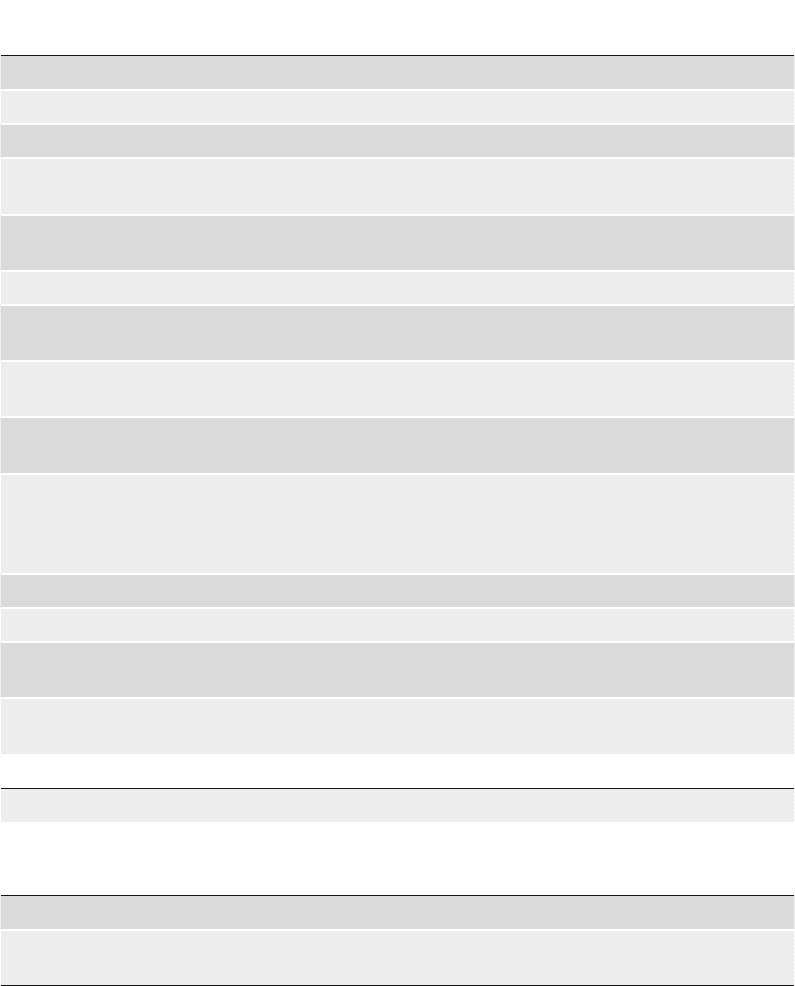
111
Automated Protein NMR Structure Determination in Solution
Table 2
Iteration 2: Parameters used within AUREMOL/KNOWNOE (see Notes 22 and 23)
Parameter Value Description
Mixing time 2D 0.08 s NOESY mixing time
Relaxation delay 1.56 s D1 plus acquisition time
Used structure Best of previous iteration Determines used 3D structure
Assign limit F1 (2D) 0.01 ppm Allowed divergence between assignment
and actual spectrum
Assign limit F2 (2D) 0.01 ppm Allowed divergence between assignment
and actual spectrum
Lower probability limit 0.95 Minimal accepted assignment probability
Distance limit 1.5 nm Allowed atom separation for possible
assignments in current structure
Mutual information prob
limit
0.1 Minimal accepted mutual information
probability
Use mutual information Yes Switches use of mutual information
on/off
Assign all peaks No Switches additional assignment of signals
on where “mutual information prob
limit” and “lower probability limit” values
are below thresholds
Assignments to master list Yes Transfers assignments to spectrum
Specify error bounds Yes Manual definition of error bounds
Upper bound dist
2
/8 Calculation of upper bounds in CNS
restraint file
Lower bound dist-0.165 nm Calculation of lower bounds in CNS
restraint file
Additional information used for the MD-calculation
As before
Results
Parameter
Value Description
Assigned signals (2D) 964 of 1,614 Number of signals assigned by KNOWNOE
RMSD 0.12 nm Average RMSD of selected structures to
mean structure (CA)
See Table 3.
See Fig. 5 and Table 4.
3.7.3. Iterations 3–5
3.7.4. Iteration 6
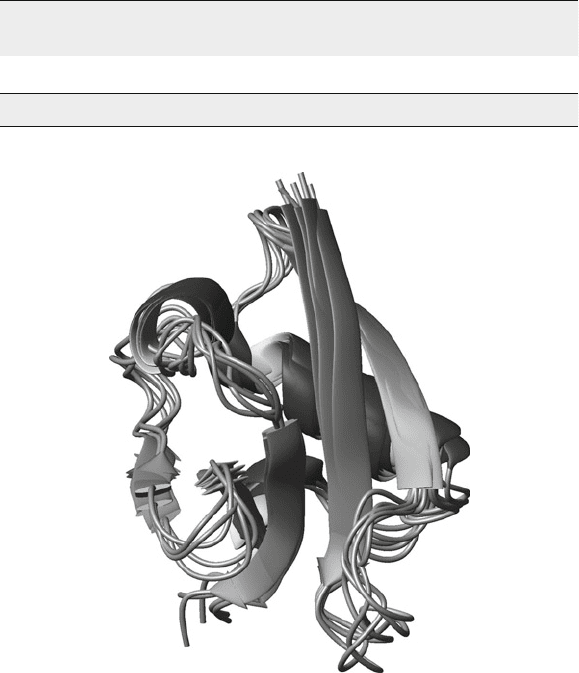
112 Gronwald and Kalbitzer
A detailed description of the various parameters is given in
the AUREMOL manual (see also Notes 22–26).
As can be seen in Fig. 1, the simulation of spectra is a central part
of AUREMOL that is used in many of its various functions such
as side-chain resonance line assignment, restraint generation, and
structure validation. For this purpose, the module RELAX was
incorporated in AUREMOL. RELAX (62–64), a program for the
back-calculation of NOESY spectra is based on the complete
relaxation matrix formalism. It differs from similar programs (65–71)
in features such as the availability of a large number of motional
models that, in principle, can be applied individually for all pairs
3.8. NOESY Spectra
Simulation Using the
Full Relaxation Matrix
Algorithm
Table 3
Iterations 3 to 5: Parameters used within AUREMOL/
KNOWNOE (see Notes 22 and 23)
Same parameters as before but upper distance limits of 1.25, 1.00, and
0.75 nm were used, respectively.
Additional information used for the MD-calculation
As before
Fig. 5. Bundle of five selected structures of RalGDS after iteration 6.
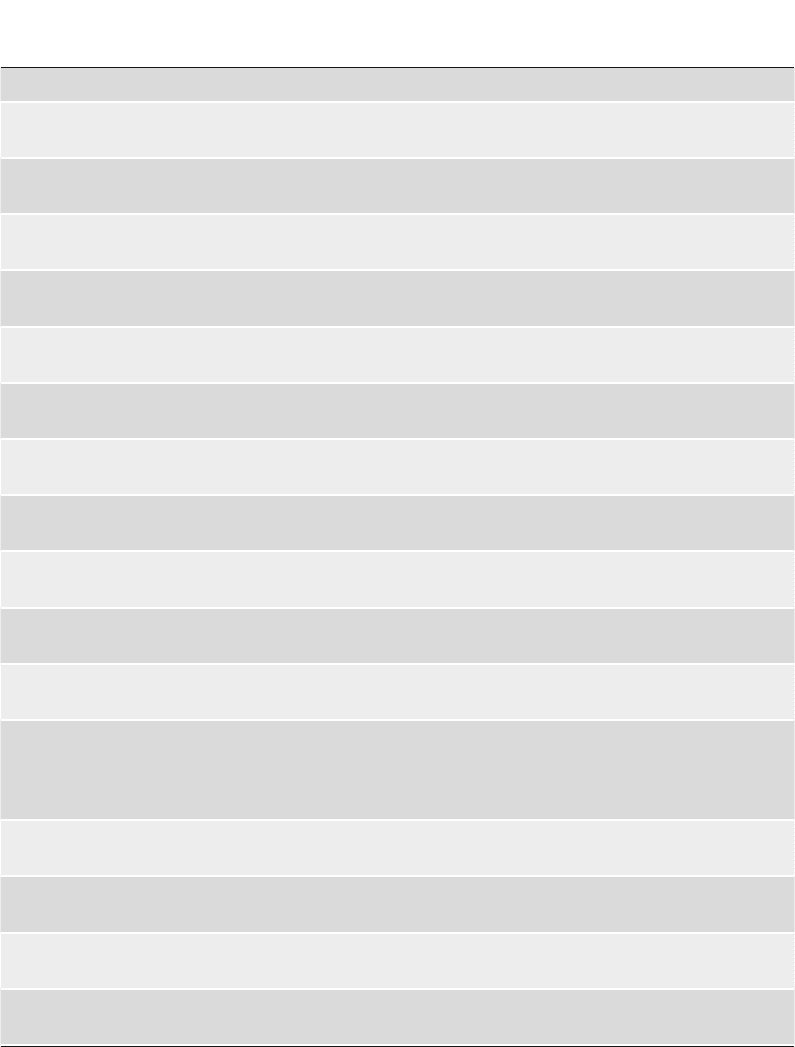
113
Automated Protein NMR Structure Determination in Solution
Table 4
Iteration 6: Parameters used within AUREMOL/KNOWNOE (see Notes 22 and 23)
Parameter Value Description
Mixing time 2D 0.08 s NOESY mixing time
Relaxation
delay
1.56 s D1 plus acquisition time
Used structure Best five of previous
iteration
Determines used 3D structure
Assign limit F1 (2D) 0.015 ppm Allowed divergence between assignment and
actual spectrum
Assign limit F2 (2D) 0.015 ppm Allowed divergence between assignment and
actual spectrum
Assign limit F1 (3D) 0.10 ppm Allowed divergence between assignment and
actual spectrum
Assign limit F2 (3D) 0.50 ppm Allowed divergence between assignment and
actual spectrum
Assign limit F3 (3D) 0.02 ppm Allowed divergence between assignment and
actual spectrum
Lower probability
limit
0.95 Minimal accepted assignment probability
Distance limit 0.75 nm Allowed atom separation for possible assignments
in current structure
Mutual information
prob limit
0.01 Minimal accepted mutual information
probability
Use mutual
information
Yes Switches use of mutual information on/off
Assign all peaks Yes Switches additional assignment of signals on
where “mutual information prob limit”
and “lower probability limit” values are
below thresholds
Assignments to
master list
Yes Transfers assignments to spectrum
Specify error
bounds
Yes Manual definition of error bounds
Upper bound Minimal
error + 0.05 nm
Calculation of upper bounds in CNS
restraint file
Lower bound Minimal
error + 0.05 nm
Calculation of lower bounds in CNS
restraint file
(continued)
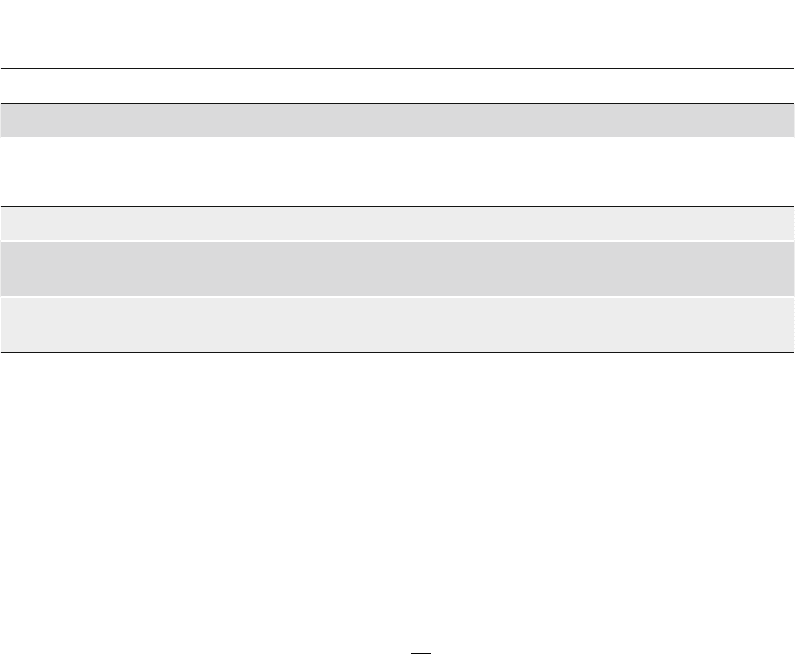
114 Gronwald and Kalbitzer
Parameter Value Description
Additional information used for the MD-calculation
As before
Results
Parameter Value Description
Assigned signals (2D) 1,442 of 1,614 Number of signals assigned by KNOWNOE
Assigned signals (3D
15
N edited)
392 of 607 Number of signals assigned by KNOWNOE
RMSD 0.06 nm Average RMSD of selected structures to mean
structure (CA)
Table 4
(continued)
of spins, and that it also includes relaxation by chemical shift
anisotropy, calculates individual T
2
values, and it allows the inclu-
sion of J-coupling patterns in the simulation. It facilitates the
simulation of
1
H 2D NOESY and
15
N or
13
C-edited 3D NOESY-
HSQC spectra. The 3D NOESY–HSQC experiment is basically a
concatenation of a homonuclear
1
H-NOESY and a heteronuclear
HSQC-experiment. In a NOESY experiment, the evolution of the
deviation of longitudinal magnetization from thermal equilibrium
DM
z
is described by the generalized Solomon equation
∆ =− ∆
zz
d
() ()
d
Mt Mt
t
D
(1)
The dynamics matrix D that governs the time evolution of
the cross-peak intensities in a 2D-NOESY experiment is given by
=+DRK
(2)
K is the kinetic matrix that describes chemical and/or confor-
mational exchange (72), while R is the relaxation matrix (73–75).
In the current version of RELAX, the effects of chemical exchange
are neglected and the solution of Eq. 3 simplifies to
∆ =∆ −
zz
( ) (0)exp( · )Mt M tR
(3)
wherein DM
z
(0) is the deviation of the longitudinal magnetization
from thermal equilibrium at time zero, i.e., directly after the last
pulse of the NOESY experiment. For dipolar homo- or hetero-
nuclear relaxation and spin I = 1/2, the rates of autorelaxation R
ii
and the cross-relaxation R
ij
between two spins i and j are given by
≠
= −+ + +
∑
0 12
( )3()6( )
ii ij ij i j ij i ij i j
ji
R qJ J Jww w ww
(4)
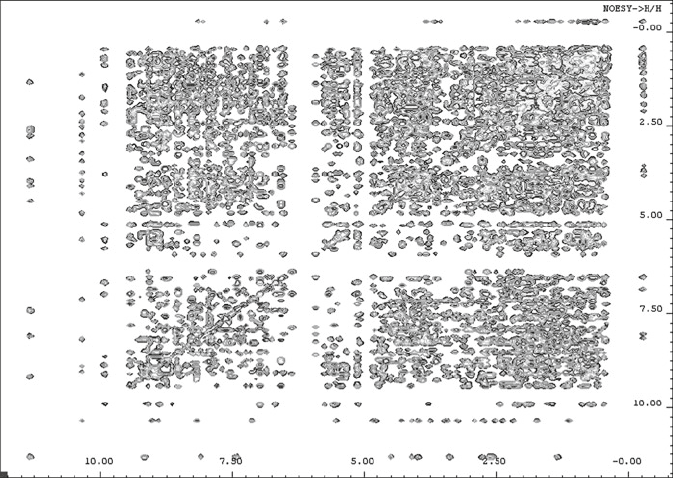
115
Automated Protein NMR Structure Determination in Solution
Fig. 6. Example for a simulated 2D 1H NOESY spectrum of the medium-sized protein HPr.
and
= +− −
20
6()()
ij ij ij i j ij i j
RqJ Jww ww
(5)
respectively. With
n
ij
J
(n = 0, 1, 2) being the spectral densities for
n-quantum transitions characterizing the motion of a vector
connecting spin i and j relative to the B
0
-field, the dipolar coupling
constants q
ij
are given by
=
222 2
0
(1/10) ( / 4 )
ij i j
qhgg m p
(6)
where g
i
and g
j
are the gyromagnetic ratios of spin i and j, respec-
tively. Within RELAX, different motional models can be used to
describe internal and external motions of the molecule. Examples
include a slow jump model to describe slow aromatic ring flips, a
fast jump model to describe fast rotating methyl groups, a rigid
model in cases where isotropic overall tumbling is assumed, and
the Lipari model free approach for internal motions not easily
described by a simple motional model.
Besides dipolar interactions RELAX also takes contributions
from chemical shift anisotropy in the relaxation matrix into account.
In addition to the calculation of accurate volumes/intensities
also individual line shapes and line widths are calculated for
each signal. For the calculation of line shapes, appropriate coupling
constants are estimated from the trial structure. Figure 6 shows
an example for a simulated 2D NOESY spectrum.

116 Gronwald and Kalbitzer
Simulation was performed with proper calculation of line-
widths and line-shapes.
The application of RELAX requires the following settings
(see also Note 26):
1. Define the pdb-file for a three-dimensional structure or a set
of three-dimensional structures.
2. Define the type of spectrum, that is, 2D-NOESY or 3D-
NOESY-HSQC spectrum.
3. Define the spectral parameters, that is, frequencies, spectral
ranges, digital resolution, repetition time, mixing time.
4. Define the relaxation parameters, that is, the global rotational
correlation time t
c
, local correlation times t
e
, type of interac-
tion (chemical shift anisotropy on/off), motional models,
order parameters S
2
. The rotational correlation time can also
be predicted by AUREMOL from the structure.
5. Define the spectrum simulation parameters, mainly J-couplings
(on/off) and additional line broadening.
One important task in the structure determination process is the
conversion of the NOE volume information into distance
restraints with appropriate error bounds. In the simplest case, one
can classify the NOEs into distance classes such as short, medium,
and long. A bit more realistic is the use of the so-called two spin
approximation with
1/ 6
·rVa
−
=
where a is a user-defined scaling
factor to take varying instrumental and experimental factors into
account. Here, often a fixed percentage of the distance is given as
lower and upper error bound. More precise is the full relaxation
matrix analysis for this purpose (67, 76) as it is, for example,
implemented in the AUREMOL module RELAX/REFINE (to
be published). Here also, spin diffusion effects are taken into
account. Based on the input structure and motional models, the
relaxation matrix is set up for the molecule of interest. In the next
step, the relaxation matrix is iteratively refined. The rates s
ij
of step
n + 1 are calculated from the rates of the previous one, s
ij
( n) by
+=
ln (exp)
( 1) ( )
ln ( ,sim)
ij
ij ij
ij
cA
nn
An
ss
(7)
with an arbitrary scaling factor c to take into account unknown
experimental and instrumental factors, the experimental cross-peak
volumes A
ij
(exp), and the corresponding simulated volumes A
ij
(n,
sim) of step n. After the autorelaxation rates have been adjusted,
new NOEs are calculated from the refined relaxation matrix and
the next iteration step is performed. After convergence, accurate
distances are obtained from the refined relaxation matrix. Minimal
error bounds are obtained from an analysis of the experimental
volume error that was determined in the peak integration step.
3.9. Calculation
of Distance Restraints
and Distance Errors
with the Full
Relaxation Matrix
Formalism
117
Automated Protein NMR Structure Determination in Solution
For using the routine REFINE the following parameters have
to be set:
1. Set parameters as for RELAX.
2. Set parameters for the error calculation. Here, one can choose
whether minimal error bounds plus an optional user error
should be selected (recommended for final cycles of automated
structure calculation, or fully user defined error bounds, such as
a certain percentage of the restraint distance, should be used).
AUREMOL provides an interface for performing structure calcu-
lations. Necessary input files are automatically created by
AUREMOL. The structure calculations itself are done by exter-
nal programs such as CYANA or CNS, whereas the analysis of the
resulting structures is again performed within AUREMOL.
One of the most important steps in any structure determination
project is the validation of the final and/or intermediate struc-
tures. Often the quality of an NMR structure is mainly judged by
factors such as RMSD values or the quality of the Ramachandran
plot. However, these methods do not provide a direct measure of
how well the calculated structures fit the experimental data.
Therefore, we have implemented the program RFAC (61, 77) in
AUREMOL, which automatically calculates R-factors for protein
NMR structures to provide such a measure. The automated R-factor
analysis envisaged here consists, in principle, of two separate
parts: (1) a comparison of the experimental NOESY spectrum
with the NOESY spectrum back-calculated from a given struc-
ture, and (2) the calculation of the R-factor(s) from the data. In
the first part, the NOESY spectrum has to be calculated from the
trial structure or a bundle of trial structures using the resonance
line assignments of the side- and main-chain atoms. For the algo-
rithm to work properly, these assignments have to be complete or
almost complete. In our implementation, we use the full relax-
ation matrix approach of the AUREMOL module RELAX to
obtain accurate simulated peaks defined by their positions, inten-
sities, and line shapes. The corresponding experimental NOESY
spectrum is as described above automatically peak picked and
integrated in the preprocessing stage of AUREMOL. In addition,
the probabilities p
i
of the peaks i to be true NMR signals and not
noise or artifact peaks are also calculated according to Bayes’ the-
orem and are used as weighting factors during the calculation of
the R-factors. For the purpose of R-factor calculation, the experi-
mental data are automatically assigned based on the correspond-
ing simulated spectrum and the sequential resonance line
assignment. Note that in difference to KNOWNOE only assign-
ments are made that could be expected from the trial structure.
The AUREMOL routine SHIFTOPT (78) is used in this process
3.10. Structure
Calculation
3.11. Structure
Validation by NMR-
R-Factor Calculations

118 Gronwald and Kalbitzer
to optimally adapt the chemical shift values obtained from the
general sequential resonance assignment to the actual experimen-
tal data. The assigned experimental and simulated spectra are fed
into the programs RFAC or in the case of 3D spectra RFAC-3D.
The presence of noise and artifact signals in the experi mental
spectrum can be further reduced by applying a lattice algorithm.
In this algorithm, only peaks are taken into account where at least
one back-calculated peak in each dimension can be found within
user-defined search radii, for example, 0.01 ppm for 2D spectra.
For resonances that are not stereospecifically assigned, the solu-
tion that fits best (gives the smallest R-factor) is selected. In this
context, one should note that for each atom at least the diagonal
peak is back calculated. Where more than one back-
calculated peak is assigned to a single experimental peak, the mean
volume of the corresponding back-calculated peaks is esti-
mated before the comparison is done, while the volume of the
experimental peak is divided by the number of corresponding
back-calculated peaks. For the calculation of R-factors, several
equations have been developed. RFAC and RFAC-3D use mainly
the one shown below.
∈∈
∈∈
−+−
=
+−
∑∑
∑∑
22 22
exp, calc, exp, exp, noise exp,
PWAUR
22 2 22
exp, exp, exp, noise exp,
( )( )
()
()
i ii i i
iA iu
ii i i
iA iu
sf V V p sf V V p
R
sf V p sf V V p
aa aa
aa
a aa
aa
a
(8)
The PWAUR R-factor (probability weighted assigned and
unassigned resonances based R-factor) takes both the assigned
(A-list) and unassigned (U-list) experimental signals into account.
Here, sf
a
is a global scaling factor to facilitate the proper scaling
between experimental and simulated spectra. V
a
noise
is a standard
noise volume to substitute for missing simulated signals,
which are not available for the unassigned experimental signals.
As mentioned above, the p
i
values describe the probability that an
experimental peak is a true signal. The parameter a is usually set
to −1/6 to ensure that the R-factor is not dominated by the
largest signals. For an ideal structure and a perfect spectrum, the
R-factor approaches a value of zero, while for erroneous struc-
tures increased values are expected.
The following steps have to be performed:
1. Carefully prepare the peak list. Be sure that the peak picking
threshold is low enough to retain the weak long-range peaks.
Set the probability cutoff at a value that the number of peaks is
smaller than twice the number of expected cross peaks.
Exclude areas where severe overlap of resonances can be
expected, that is, in homonuclear 2D-NOESY spectra usually
the upfield range between 0.3 and 4 ppm.

119
Automated Protein NMR Structure Determination in Solution
2. Before starting the calculation be sure that the chemical shift
table corresponds closely to the conditions used for the record-
ing of the NOESY spectrum. Apply the chemical shift opti-
mization routine AUREMOL-SHIFTOPT (78) that adapts
the shift table to the actual spectrum.
3. Set the parameters of the NOESY-back calculation routine
correctly. Especially give the correct mixing time, repetition
time, and
1
H-frequency. Improved results are obtained when
the correct motional models and motional parameters like
external (global) and internal correlation times, order param-
eters etc., are specified. Since usually experimentally derived
order parameters are not available for side-chain atoms, RELAX
provides for these average values obtained from the literature.
4. Select an NMR R-factor most suitable for your actual
problem.
5. In case that several different experimental NOESY spectra are
available, it is advised to calculate an average R-factor (61).
The following notes summarize important points that should be
considered in the automated structure determination process.
The sections where a detailed description of these subjects can be
found are given in parentheses.
1. Carefully optimize your protein sample and the experimental
conditions (also see Subheading 2.2).
2. Do not start acquisition of multidimensional spectra and data
evaluation before the system is really optimized. Experience
shows that after a necessary improvement of the sample
conditions, the results obtained earlier are discarded (also see
Subheading 2.2).
3. For automated procedures, >90% of all expected resonances
should be visible (also see Subheading 2.2).
4. When automated methods are to be used, perform the set
of experiments required by the specific software (also see
Subheading 2.3).
5. For the processing of the experimental spectra, the use of
an appropriate filter is important; as a rule of thumb, a filter
that induces an additional line broadening of approximately
30% gives a clear improvement of the signal-to-noise ratio
without significantly deteriorating the resolution (also see
Subheading 3.3).
6. Be aware when filtering FIDs in the processing step that the
filter characteristics of the used filter depend often on the digital
4. Notes
